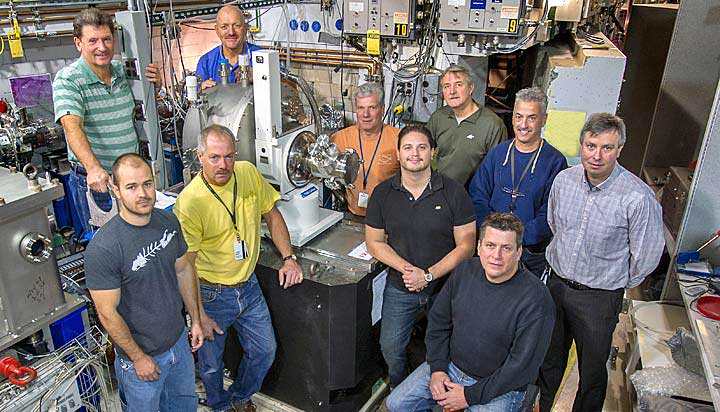As NSLS is Dismantled, NxtGen Assures Us That it Will Live On
November 25, 2014
 enlarge
enlarge
Members of the team tasked with removing equipment from NSLS to be a reused at the future NSLS-II NxtGen beamlines: (back row, from left to right) Dennis Carlson and Ray Ceruti; (middle row) Drew Carleton, Dan Sullivan, Rick Green, Gary Nintzel, Mike Caruso, and Julian Adams; (front row) Mike Hartsough and Tom Van Winckel. They are standing near the NSLS X9 monochromator, which will be given a new life at the CMS beamline at NSLS-II.
Inside the building of the now-dark NSLS, a team of technicians and scientists has spent the last two months painstakingly removing more than 800 items of equipment – and they are not done yet. They will retrieve hundreds of additional items between now and the end of the calendar year, totaling upwards of 1,500. Each piece will be given a new purpose at one of the eight NSLS-II NxtGen beamlines, which have been designed to reuse much of the equipment from the NSLS.
For many involved, the removal process has been, at times, a sad and nostalgic experience.
“Initially, there was some trepidation about taking everything apart,” said Julian Adams, the NxtGen project leader. “Some of the equipment has been in place since the facility was built in 1982, and some of the techs involved in the removal had helped put it together.”
But the mood has become more upbeat of late.
“The team has a deeper understanding that the equipment is being given a new life and will provide good service for a long period to come,” he said. “And the techs will be the ones putting everything back together again into new beamlines – beamlines that will be the best in the world.”
Adams stressed the importance of making sure that the reclaimed equipment would meet the most current operating specifications. The NxtGen team essentially had to guarantee that the new beamlines would perform at a world-class level despite containing equipment that was, in some cases, decades old.
This promise wasn't at all far-fetched. Despite their ages, many of the pieces are ready for much more science. For example, parts from vacuum and motion systems are easy to reuse because they “get a pretty easy life, so they last a long time,” says Adams. Some of the optics inside of them, however, will be new. The old optics pieces that have been selected to make the move to NSLS-II will be cleaned and recoated, as over the years the mirrors have become dirtied with carbon deposits.
Several items weren't all that old to begin with. For example, the future Complex Materials Scattering (CMS) beamline at NSLS-II will be built using NSLS parts that were installed only six years ago. Other pieces are even newer, having been installed at NSLS only about two years ago with the knowledge that they would be removed to take to NSLS-II.
When combined with plenty of new hardware, like hutches, electrical systems, frontends, and controls systems, the old equipment will make up beamlines expected to last 20 years.
Besides the practicality of reusing perfectly serviceable equipment, and the feel-good aspect of incorporating pieces of the old light source into the new one, there is a budgetary justification: Reusing equipment saves a lot of money. To spiff up the reclaimed parts — which include x-ray mirrors, monochromators, endstations, and vacuum systems pumps, valves, and controllers — the cost is about $4 million. To purchase all-new equipment, the cost would have been about $35 million.
The removal of equipment earmarked for NSLS-II is just one component of the NSLS “stabilization” effort, which also consists of permanently shutting down and de-energizing the accelerator, returning user property to their home institutions, properly dispositioning the government-owned bar-coded equipment, and properly disposing of the chemicals, cylinders and samples on the experimental floor.
Construction of the NxtGen beamlines at NSLS-II will begin in June 2015.
2014-5379 | INT/EXT | Newsroom









